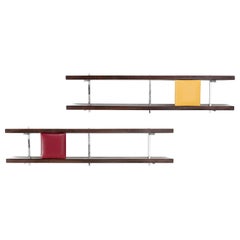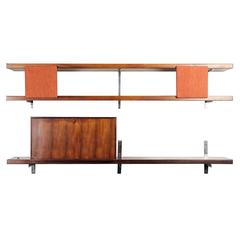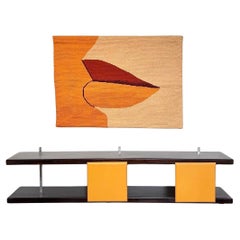Sergio Rodrigues George Nelson
Vintage 1960s Brazilian Shelves and Wall Cabinets
Chrome
Recent Sales
Vintage 1960s Brazilian Mid-Century Modern Shelves and Wall Cabinets
Rosewood
Mid-20th Century Brazilian Mid-Century Modern Bookcases
Metal
Vintage 1960s Brazilian Shelves and Wall Cabinets
Metal
People Also Browsed
Vintage 1960s Danish Scandinavian Modern Dining Room Chairs
Fabric, Teak
Vintage 1960s Danish Mid-Century Modern Sideboards
Rosewood
2010s Finnish Post-Modern Coat Racks and Stands
Cement, Aluminum
Vintage 1960s Danish Mid-Century Modern Sideboards
Teak
Vintage 1960s Danish Mid-Century Modern Sideboards
Rosewood
2010s Italian Modern Table Mirrors
Concrete, Stainless Steel
20th Century Mid-Century Modern Console Tables
Plastic, Wood, Beech, Birch, Walnut, Burl
Mid-20th Century Danish Scandinavian Modern Daybeds
Fabric, Foam, Teak
2010s German Coat Racks and Stands
Steel
Vintage 1960s French Mid-Century Modern Coffee and Cocktail Tables
Ceramic, Teak
2010s Brazilian Minimalist Chairs
Stainless Steel
Vintage 1960s Italian Mid-Century Modern Cabinets
Aluminum
Late 20th Century Italian Post-Modern Table Lamps
Art Glass
Vintage 1950s Indian Dining Room Chairs
Cowhide, Teak
21st Century and Contemporary Brazilian Minimalist Armchairs
Steel
Vintage 1980s Italian Table Lamps
Glass
Sergio Rodrigues George Nelson For Sale on 1stDibs
How Much is a Sergio Rodrigues George Nelson?
Sergio Rodrigues for sale on 1stDibs
The prolific architect and designer Sergio Rodrigues is often called the "father of modern Brazilian design," but it is the second adjective in that phrase that deserves emphasis: Rodrigues’s great achievement was to create furniture in a style that captured the spirit, character and personality of his country.
Modernity came slowly to 20th-century Brazil, politically and culturally. The nation finally realized genuine constitutional democracy in 1945, ushering in a new, progressive era in the arts. More often than not, the luxurious furnishings of that time and place, with their gleaming wood, soft leathers and inviting shapes, share a sensuous, uniquely Brazilian quality that distinguishes them from the more rectilinear output of American mid-century modernists and Scandinavian makers of the same era. Until that time in Brazil, heavy furniture based on historical European models had been the norm.
In the late 1940s, designer Joaquim Tenreiro introduced sleek, minimalist chairs and cabinets; José Zanine Caldas, now best known for his later artisanal work, created plywood furnishings for mass production; the Italian architect Lina Bo Bardi, a former editor for the Gio Ponti-founded magazine Domus — and a furniture designer with talent, imagination and a social conscience — set up shop in São Paulo, designing elegant, flexible chairs set on slim metal frames.
This was the heady scene into which Rodrigues, the son of an artistically prominent Rio de Janeiro family, arrived after graduating in 1952 from the national university. He moved to Curitiba and helped establish the furniture manufacturer Móveis Artesanal with Italian designer Carlo Hauner and Austrian architect Martin Eisler — as well as Carlo’s brother Ernesto Hauner — which eventually rebranded as Forma. Later, Rodrigues relocated to Rio de Janeiro where he founded Oca in 1955, a company that would become the preeminent maker and retailer of modernist furniture in Brazil.
When architects Lúcio Costa and Oscar Niemeyer were tasked in 1956 with the whirlwind project to plan, design and build the new capital, Brasília, in five years, they used Rodrigues’s early chairs, with their softly-contoured lines and caned seats and backrests, to furnish many of the buildings.
Rodrigues would realize the true expression of his talents in — and garner international awards and acclaim with — his Mole chair of 1957. The word mole means "soft" in Portuguese, but can be interpreted as "easygoing" or even "listless." The chair, which is also known as the Sheriff chair, features a sturdy, generously proportioned frame of the native South American hardwood jacaranda, upholstered with overstuffed leather pads that flap like saddlebags across the arms, seat, and backrest.
Rodrigues's Mole chair invites sprawling — perfect for the social milieu of the bossa nova and caipirinha cocktails; where a languorous afternoon spent chatting and joking is the apex of enjoyment. The seat won first prize at the IV Concorso Internazionale del Mobile in Cantù, Italy, in 1961, and ISA Bergamo acquired the rights to manufacture a modified version of Rodrigues’s original design.
In 1963, Rodrigues established a shop called Meia-Pataca, which sold simpler and more affordable furniture he had designed, such as his Tonico seating, which was intended for student housing.
Most of the estimated 1,200 armchairs, sofas, tables, storage cabinets and dining tables Rodrigues created in his long career are imbued, in one way or another, with the air of robust relaxation that defines the Mole chair. He was a designer who was true to the temperament of his people.
Find vintage Sergio Rodrigues furniture for sale on 1stDibs.
On the Origins of Brazilian
More often than not, vintage mid-century Brazilian furniture designs, with their gleaming wood, soft leathers and inviting shapes, share a sensuous, unique quality that distinguishes them from the more rectilinear output of American and Scandinavian makers of the same era.
Commencing in the 1940s and '50s, a group of architects and designers transformed the local cultural landscape in Brazil, merging the modernist vernacular popular in Europe and the United States with the South American country's traditional techniques and indigenous materials.
Key mid-century influencers on Brazilian furniture design include natives Oscar Niemeyer, Sergio Rodrigues and José Zanine Caldas as well as such European immigrants as Joaquim Tenreiro, Jean Gillon and Jorge Zalszupin. These creators frequently collaborated; for instance, Niemeyer, an internationally acclaimed architect, commissioned many of them to furnish his residential and institutional buildings.
The popularity of Brazilian modern furniture has made household names of these designers and other greats. Their particular brand of modernism is characterized by an émigré point of view (some were Lithuanian, German, Polish, Ukrainian, Portuguese, and Italian), a preference for highly figured indigenous Brazilian woods, a reverence for nature as an inspiration and an atelier or small-production mentality.
Hallmarks of Brazilian mid-century design include smooth, sculptural forms and the use of native woods like rosewood, jacaranda and pequi. The work of designers today exhibits many of the same qualities, though with a marked interest in exploring new materials (witness the Campana Brothers' stuffed-animal chairs) and an emphasis on looking inward rather than to other countries for inspiration.
Find a collection of vintage Brazilian furniture on 1stDibs that includes chairs, sofas, tables and more.


